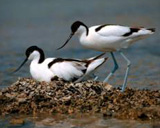 The primary reason that our feathered friends
migrate South in the Fall, or North in the Spring, does not solely
lie in the cold of winter, as most are well-equipped to survive in
extreme temperatures, but instead lies with the upcoming shortage of
food. Mother Nature endowed birds with
an internal clock that warns them to get out-of-town, or to face
possible starvation. Because birds can detect seasonal changes, they
take note when the days become shorter, and fly South in search of
alternate food sources, only to return home again in the Spring when
there is an abundance of tasty insects, or small, scurrying rodents. The primary reason that our feathered friends
migrate South in the Fall, or North in the Spring, does not solely
lie in the cold of winter, as most are well-equipped to survive in
extreme temperatures, but instead lies with the upcoming shortage of
food. Mother Nature endowed birds with
an internal clock that warns them to get out-of-town, or to face
possible starvation. Because birds can detect seasonal changes, they
take note when the days become shorter, and fly South in search of
alternate food sources, only to return home again in the Spring when
there is an abundance of tasty insects, or small, scurrying rodents.
An additional trigger for birds to migrate is the need to breed
to repopulate their species. Often,
they return in the spring to procreate
in the exact nesting spot they vacated in the fall. Birds certainly
do qualify as creatures of habit!
The streamlined birds go to great
lengths to make their migratory trips, sometimes flying as far as to
other continents, or from the lowlands
to the highlands, or from the interior of a country to the seashore.
The Arctic tern holds the long-distance
medal for travel, as he travels from Antarctica to Massachusetts,
logging up to 22,000 miles in stretches of up to 1,000 miles per
week. Unfortunately, he does not rack
up frequent flyer miles! Most
land-lubbers make puddle-jumper like flights, with the
exception of the American Golden
Plover, who undertakes a non-stop, direct flight over the
open expanse of ocean, from Nova Scotia
to South America, without making one stop!
For some reason, most migratory birds schedule their annual
departure and return dates close to, or on the same day, as in the
previous year. Their timing, however,
is not exact, as is the case with the legendary swallows of
Capistrano, California. Reportedly, their annual migration begins
like clockwork on October 23, and ends
with their return on March 19. The legendary swallows sometimes do
disappoint and vary their migratory schedule, much to the chagrin of
the California Division of Tourism!
No scientific certainty exists as to how migratory birds
establish their flight plans or patterns. They are not blessed with
the bat's radar system, so fly-by-night birds have no physical
landmarks to guide them, and those who make overseas flights have no
landmarks to go by, even during the daylight hours. The most
prevalent, plausible theory is that migratory birds sense the magnetic fields that surround the earth, and
guide their flights by these lines,
which stretch from North to South. How else would young birds, who
have logged no flight miles, successfully complete their migrations,
especially in light of the fact that their mothers leave them in the
dust, and begin their migrations first? Whatever the reason, neither
snow nor rain nor heat nor gloom of night stays these birds from the
swift completion of their annual migrations!
|
|
note:
|
Mother Nature: 自然的力量
scurrying rodents:
跑得很快的啮齿动物
repopulate:
增加(人口)
procreate: 生殖,生育
streamlined: 流线型的
lowland: 低地
Arctic tern: 北极燕鸥
rack up: 获胜
land-lubber: “旱鸭子”
Golden Plover: 金斑行鸟
Nova Scotia: 新斯科舍省(加拿大东部的省)
timing: 时间选择
like clockwork: 精确地,有规律地
magnetic fields: 磁场
line: 磁力线
note:
北极燕鸥可以说是鸟中之王。
它们在北极繁殖,但却要到
南极去越冬,每年在两极之
间往返一次,行程数万千米。
| |